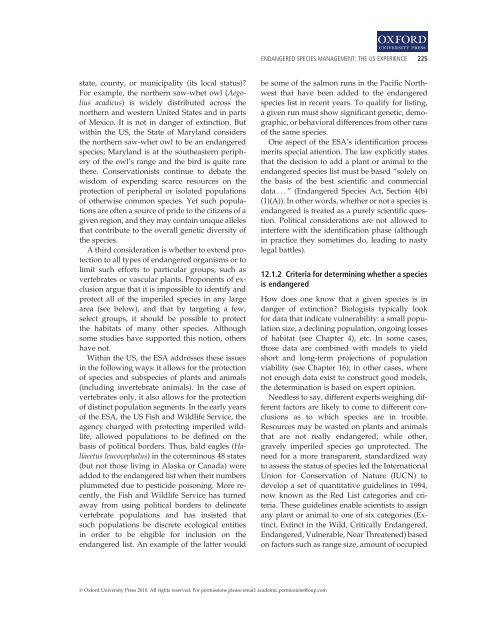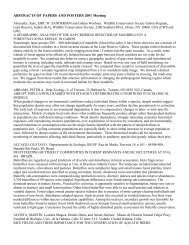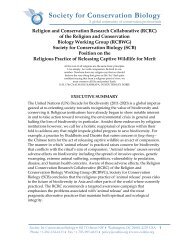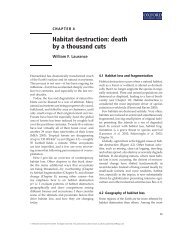Endangered species management: the US experience - Society for ...
Endangered species management: the US experience - Society for ...
Endangered species management: the US experience - Society for ...
You also want an ePaper? Increase the reach of your titles
YUMPU automatically turns print PDFs into web optimized ePapers that Google loves.
1<br />
ENDANGERED SPECIES MANAGEMENT: THE <strong>US</strong> EXPERIENCE 225<br />
state, county, or municipality (its local status)<br />
For example, <strong>the</strong> nor<strong>the</strong>rn saw-whet owl (Aegolius<br />
acadicus) is widely distributed across <strong>the</strong><br />
nor<strong>the</strong>rn and western United States and in parts<br />
of Mexico. It is not in danger of extinction. But<br />
within <strong>the</strong> <strong>US</strong>, <strong>the</strong> State of Maryland considers<br />
<strong>the</strong> nor<strong>the</strong>rn saw-whet owl to be an endangered<br />
<strong>species</strong>; Maryland is at <strong>the</strong> sou<strong>the</strong>astern periphery<br />
of <strong>the</strong> owl’s range and <strong>the</strong> bird is quite rare<br />
<strong>the</strong>re. Conservationists continue to debate <strong>the</strong><br />
wisdom of expending scarce resources on <strong>the</strong><br />
protection of peripheral or isolated populations<br />
of o<strong>the</strong>rwise common <strong>species</strong>. Yet such populations<br />
are often a source of pride to <strong>the</strong> citizens of a<br />
given region, and <strong>the</strong>y may contain unique alleles<br />
that contribute to <strong>the</strong> overall genetic diversity of<br />
<strong>the</strong> <strong>species</strong>.<br />
A third consideration is whe<strong>the</strong>r to extend protection<br />
to all types of endangered organisms or to<br />
limit such ef<strong>for</strong>ts to particular groups, such as<br />
vertebrates or vascular plants. Proponents of exclusion<br />
argue that it is impossible to identify and<br />
protect all of <strong>the</strong> imperiled <strong>species</strong> in any large<br />
area (see below), and that by targeting a few,<br />
select groups, it should be possible to protect<br />
<strong>the</strong> habitats of many o<strong>the</strong>r <strong>species</strong>. Although<br />
some studies have supported this notion, o<strong>the</strong>rs<br />
have not.<br />
Within <strong>the</strong> <strong>US</strong>, <strong>the</strong> ESA addresses <strong>the</strong>se issues<br />
in <strong>the</strong> following ways: it allows <strong>for</strong> <strong>the</strong> protection<br />
of <strong>species</strong> and sub<strong>species</strong> of plants and animals<br />
(including invertebrate animals). In <strong>the</strong> case of<br />
vertebrates only, it also allows <strong>for</strong> <strong>the</strong> protection<br />
of distinct population segments. In <strong>the</strong> early years<br />
of <strong>the</strong> ESA, <strong>the</strong> <strong>US</strong> Fish and Wildlife Service, <strong>the</strong><br />
agency charged with protecting imperiled wildlife,<br />
allowed populations to be defined on <strong>the</strong><br />
basis of political borders. Thus, bald eagles (Haliaeetus<br />
leucocephalus) in <strong>the</strong> coterminous 48 states<br />
(but not those living in Alaska or Canada) were<br />
added to <strong>the</strong> endangered list when <strong>the</strong>ir numbers<br />
plummeted due to pesticide poisoning. More recently,<br />
<strong>the</strong> Fish and Wildlife Service has turned<br />
away from using political borders to delineate<br />
vertebrate populations and has insisted that<br />
such populations be discrete ecological entities<br />
in order to be eligible <strong>for</strong> inclusion on <strong>the</strong><br />
endangered list. An example of <strong>the</strong> latter would<br />
be some of <strong>the</strong> salmon runs in <strong>the</strong> Pacific Northwest<br />
that have been added to <strong>the</strong> endangered<br />
<strong>species</strong> list in recent years. To qualify <strong>for</strong> listing,<br />
a given run must show significant genetic, demographic,<br />
or behavioral differences from o<strong>the</strong>r runs<br />
of <strong>the</strong> same <strong>species</strong>.<br />
One aspect of <strong>the</strong> ESA’s identification process<br />
merits special attention. The law explicitly states<br />
that <strong>the</strong> decision to add a plant or animal to <strong>the</strong><br />
endangered <strong>species</strong> list must be based “solely on<br />
<strong>the</strong> basis of <strong>the</strong> best scientific and commercial<br />
data ...” (<strong>Endangered</strong> Species Act, Section 4(b)<br />
(1)(A)). In o<strong>the</strong>r words, whe<strong>the</strong>r or not a <strong>species</strong> is<br />
endangered is treated as a purely scientific question.<br />
Political considerations are not allowed to<br />
interfere with <strong>the</strong> identification phase (although<br />
in practice <strong>the</strong>y sometimes do, leading to nasty<br />
legal battles).<br />
12.1.2 Criteria <strong>for</strong> determining whe<strong>the</strong>r a <strong>species</strong><br />
is endangered<br />
How does one know that a given <strong>species</strong> is in<br />
danger of extinction Biologists typically look<br />
<strong>for</strong> data that indicate vulnerability: a small population<br />
size, a declining population, ongoing losses<br />
of habitat (see Chapter 4), etc. In some cases,<br />
those data are combined with models to yield<br />
short and long-term projections of population<br />
viability (see Chapter 16); in o<strong>the</strong>r cases, where<br />
not enough data exist to construct good models,<br />
<strong>the</strong> determination is based on expert opinion.<br />
Needless to say, different experts weighing different<br />
factors are likely to come to different conclusions<br />
as to which <strong>species</strong> are in trouble.<br />
Resources may be wasted on plants and animals<br />
that are not really endangered, while o<strong>the</strong>r,<br />
gravely imperiled <strong>species</strong> go unprotected. The<br />
need <strong>for</strong> a more transparent, standardized way<br />
to assess <strong>the</strong> status of <strong>species</strong> led <strong>the</strong> International<br />
Union <strong>for</strong> Conservation of Nature (IUCN) to<br />
develop a set of quantitative guidelines in 1994,<br />
now known as <strong>the</strong> Red List categories and criteria.<br />
These guidelines enable scientists to assign<br />
any plant or animal to one of six categories (Extinct,<br />
Extinct in <strong>the</strong> Wild, Critically <strong>Endangered</strong>,<br />
<strong>Endangered</strong>, Vulnerable, Near Threatened) based<br />
on factors such as range size, amount of occupied<br />
© Ox<strong>for</strong>d University Press 2010. All rights reserved. For permissions please email: academic.permissions@oup.com






